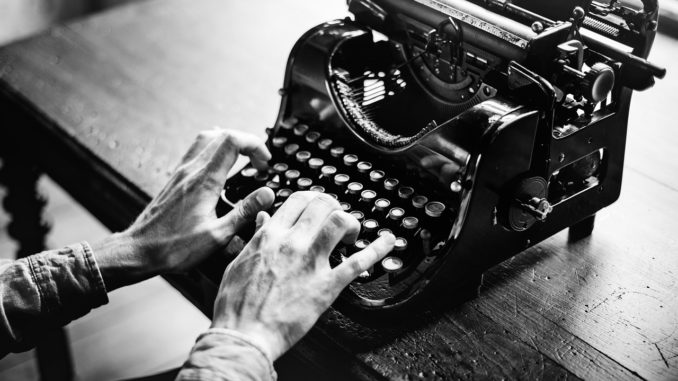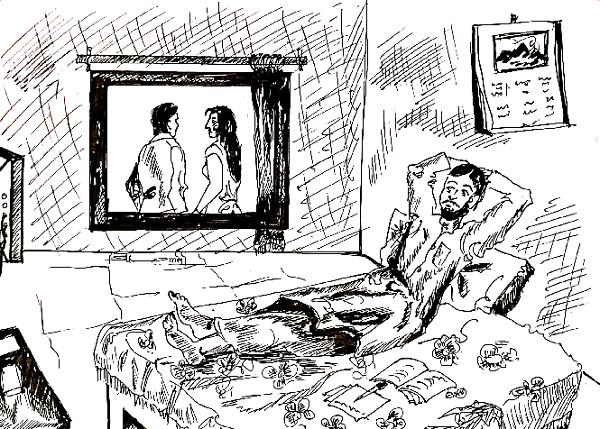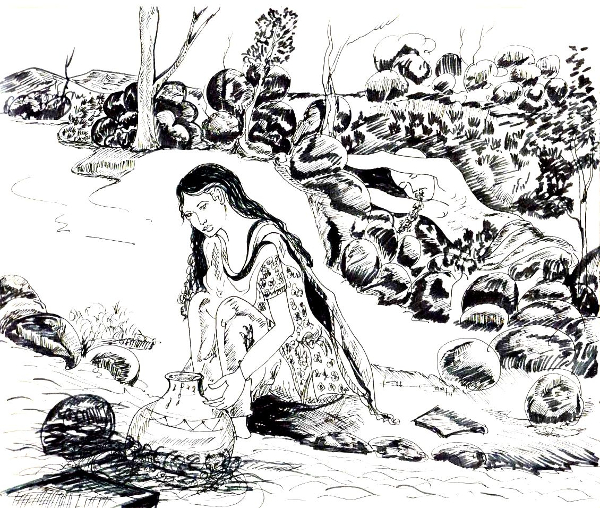
The Short Story
by
Dr. Anita Sharma
Volume 1, Issue 1, Pg 03-04
⊕
A short story can give artistic expression to supreme moments in life, and this accounts for the wide popularity enjoyed by this genre in modern times. It is but natural that in today’s busy life, shorter literary forms with concentrated effects are preferred to voluminous epics. The desire to listen to stories is deeply rooted in human civilization the world over. Man, being a social animal, is always interested in another man’s life. This feature of man’s mind might have created the art of story-telling. Short stories date back to oral story-telling traditions, which originally produced epics, such as Homer’s Iliad and Odyssey. A short story is a piece of fictional work of prose that is shorter in length than a novel, and can usually be read in one sitting.[1] “A short story can be a fable or a parable, real, fantasy, a true presentation or a parody, sentimental or satirical, serious in intention or light-hearted diversion; it can be any of these, but to be memorable it must catch the eternal … immensity of time.” [2]
It has manifested itself in diversified forms, such as sketch, yarn, Marchen, parable, novella, cycles, and so on. Sketch appears static in its nature as Washington Irving states, it is the “play of the thought, and sentiments and language: the weaving in of characters, lightly yet expressively delineated; the familiar and faithful exhibition of scenes in common life; and the half concealed vein of humour that is often playing through the whole.”[3]
The word ‘yarn’ seems to be derived from rope making, which is much connected with the nautical field. Further, it seems to have been applied metaphorically for story weaving.
Marchen is an adopted form of the fairy tale by a modern writer, wherein faerie is usually replaced by magic. In Marchen, there is a profusion of supernatural elements.
A parable is a story, which is didactic in tone and realistic in its approach to life, intending to bring home some moral. Likewise, fable is a story, intending to teach a moral by employing animals as characters, which act as if they were human beings.
A novella is another form of literature, the aspects of which appear to be different from that of a normal work of fiction on one hand and short story on the other, which crosses and goes beyond the regulation of the short story proper and also does not fit properly into the framework of the novel proper.
The short story is a comparatively recent development in English literature. In Europe, the oral story-telling tradition began to develop into written stories in the early 14th century, with Geoffrey Chaucer’s Canterbury Tales and Giovanni Boccaccio’s Decameron. Both of these books are composed of individual short stories set within a larger narrative story. At the end of the 16th century, some of the most popular short stories in Europe were the darkly tragic ‘novella’ of Matteo Bandello.
The mid-17th century in France saw the development of a refined short novel, the ‘nouvelle’, by authors, such as Madam de Lafayette. The appearance of Antoine Galland’s first modern translation of the Thousand and One Nights or Arabian Nights had an enormous influence on the 18th century European short stories of Voltaire, Diderot and others. The first short stories in the United Kingdom were gothic tales, such as Richard Cumberland’s The Prisoner of Montremos (1791). Great novelists, such as Sir Walter Scott and Charles Dickens also wrote some short stories.
ΞΞΞΞΞΞΞΞΞΞΞΞΞΞΞΞΞΞΞΞ
Sponsored Link(s)
ΞΞΞΞΞΞΞΞΞΞΞΞΞΞΞΞΞΞΞΞ
One of the earliest short stories in the United States was Charles Brockden Brown’s Somnambulism. Washington Irving wrote mysterious tales, including Rip van Winkle (1819) and The Legend of Sleepy Hollow (1820). Nathaniel Hawthorne published the first part of his Twice-Told Tales in 1837. Edgar Allan Poe wrote his tales of mystery and imagination between 1832 and 1849. Classic stories are ‘The Fall of the House of Usher’, ‘The Tell-Tale Heart’, ‘The Cask of Amontillado’, ‘The Pit and the Pendulum’, and the first detective story, ‘The Murders in the Rue Morgue’.
In Germany, the first collection of short stories was by Heinrich von Kleist in 1810 and 1811. The Brothers Grimm published their first volume of collected fairy tales in 1812. E. T. A. Hoffmann followed with his own original fantasy tales, of which The Nutcracker and the Mouse King (1816) are the most famous.
In the later 19th century, the growth of print magazines and journals created a strong demand for short fiction. With rapid industrialisation, people got less time to read long pieces of literature. They expected to read something interesting in a short period, and in a single sitting. This demand was fulfilled by the short story and soon it became a popular genre. In the United Kingdom, Thomas Hardy wrote dozens of short stories, including ‘The Three Strangers’ (1883), ‘A Mere Interlude’ (1885) and ‘Barbara of the House of Grebe’ (1890). Rudyard Kipling published the short story collections, such as Plain Tales from the Hills (1888) for grown-ups as well as The Jungle Book (1894) for children. In 1892, Arthur Conan Doyle brought the detective story to a new height with The Adventures of Sherlock Homes. H. G. Wells wrote his first science fiction stories in the 1880s, while Herman Melville published his story collection, The Piazza Tales, in 1856.
The most prolific French author of short stories was Guy de Maupassant. In Russia, Ivan Turgenev gained recognition with his story collection A Sportsman’s Sketches. Nikolai Leskov created his first short stories in the 1860s. In the United Kingdom, periodicals, such as The Strand Magazine, The Sketch, Harper’s Magazine and Story-Teller contributed to the popularity of the short story. Hector Hugh Munro (1870-1916), also known by the pen name, Saki, wrote satirical short stories about Edwardian England. In Ireland, James Joyce published his short story collection, Dubliners in 1914.
The period following World War II saw a great flowering of literary short fiction in the United States. The New Yorker continued to publish the works of the form’s leading mid-century practitioners, including Shirley Jackson, whose story, ‘The Lottery’ published in 1948, had elicited the strongest response in the magazine’s history at the time.
The first years of the 21st century saw the emergence of a new generation of young writers, including Jhumpa Lahiri, Uma Parameswaran, Farida Karodia, Shauna Singh Baldwin, Karen Russell, Nathan Englander, Kevin Brockmeier, George Saunders, German-American bilingual writer, Paul-Henri Campbell, and Dan Chaon. Blogs and e-zones joined traditional paper-based literary journals to showcase the work of emerging authors.
Thus, the development of the short story is distinctive. Its growth suggests the popularity of this genre. The most important elements of the short story are plot, characters, narrative perspective (point of view) and setting. In ancient India, it was believed that listening or narrating a story grants merit to the one who narrates it as well as to the one who listens to it. Stories were held in high esteem as an inexhaustible source of teaching and delight, a fit medium to inculcate values. The tradition was carried on by common people who relied on the treasure found in great Indian epics, as well as folk narratives. Ancient Indian epics, such as the Ramayana and the Mahabharata are not based on a single plot; they are a series of stories related to the central plot.
The first written collection of stories from India is the Panchtantra. It is also the first Indian book to be translated into many western languages. Another famous literary collection of Indian folk tales is in Sanskrit, called Kathasaritsagara, which means ocean or sea of stories, by Somdeva written around 1070. Folk Tales of India by Ramanujan—a collection of oral tales from 22 languages—comprises stories written originally in Tulu, a Dravidian language.
Hindi writers, such as Munshi Prem Chand, Jaya Shankar Prasad, Rabindranath Tagore, Acharya Chatursen, Janandra Kumar, Yash Pal and many more contributed to the genre. Story telling is a skill that comes quite naturally to human beings, particularly Indians, because of their being fed on grandmother’s tales since their infancy and also because of their ancient, rich and continuing traditions. The Indian English short story can be traced back to the Brihatkatha Saritsagara of Gunadhya and the Jataka Tales of Buddha. Starting with S.C. Dutt’s Realities of Indian Life (1885), the tribe of short story writers has continued to increase and allure readers.
ΞΞΞΞΞΞΞΞΞΞΞΞΞΞΞΞΞΞΞΞ
Sponsored Link(s)
ΞΞΞΞΞΞΞΞΞΞΞΞΞΞΞΞΞΞΞΞ
Dr. Anita Sharma has been teaching English to undergraduate and postgraduate students since 1989, in various colleges of Maharashtra and Himachal
Pradesh.
At present, she is teaching at Rajkiya Kanya Mahavidylaya (RKMV), Shimla (H.P).
Besides being on the the editorial board of journals like Research Digest, Ripples, Langlit, and DJ JELAL, she has published two critical books on American and Canadian Poets, and more than fifty scholarly articles.



ΞΞΞΞΞΞΞΞΞΞΞΞΞΞΞΞΞΞΞΞ
Sponsored Link(s)
ΞΞΞΞΞΞΞΞΞΞΞΞΞΞΞΞΞΞΞΞ






good link how to send stories for consideration.
I am sorry for the delay in replying. You can send your stories to [email protected]
Very informative.